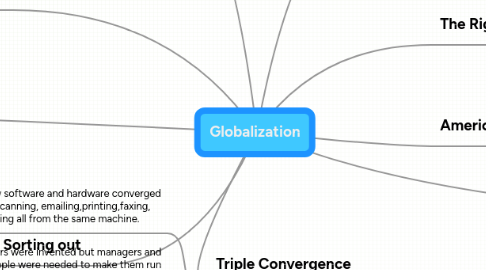
1. Triple Convergence
1.1. Workflow software and hardware converged to offer scanning, emailing,printing,faxing, and copying all from the same machine.
1.2. Computers were invented but managers and other people were needed to make them run effiecntly.
1.3. More people are allowed to compete develop new jobs and habits for horizontal collaboration.
2. The Great Sorting out
2.1. There is less human contact now in days, when you call a company you now get a voice recording. You also get in with doctors, when you call and you now have to pick your doctor and an opinion in order to make an appointment. Things are less personable.
3. The Quiet Crisis
3.1. Ambition Gap
3.1.1. People dont have the time or modivation to work hard. They are also lets modivated to work in low paying jobs.
3.2. Number Gap
3.2.1. The number of engineering and science majors needed will grow in the U.S.A.
3.3. Education Gap at the top
3.3.1. Americans spend too much time watching tv then studying.
3.3.2. 60% of students in Math and science are children of recent immigrants
3.4. Funding Gap
3.4.1. US has good colleges and universitys but lacks in grade school education. We lack a national policy for education where others countries have successful policys.
3.5. Education Gap at the bottom
3.5.1. US schools have low expectations of students. Seperates students based on class and wealth.
3.6. Infrastructure Gap
3.6.1. US spends too much on military but not on education. Falling behind in broadband.
4. The Right Stuff
4.1. New people are needed intodays world. They contain all the skills nessary to work in the flat world. It ranges from managers to people that can communicate with customers or other countries.
5. The Middle Class
5.1. Collaborators and Orchestrators
5.2. Sythesizers
5.3. Explainers
5.4. Leveragers
5.5. Adapters
5.6. Green People
5.7. Passionate Personalizers
5.8. Math Lovers
5.9. Localizers
6. History of...
6.1. 1.0
6.1.1. Countries & Muscles
6.1.1.1. Who was more powerful depended on who had the most techological advances.
6.2. 2.0
6.2.1. Multinational Companies
6.2.1.1. Companies boosted the market and transportation cost decreased from steam power.
6.3. 3.0
6.3.1. More driven than 1.0 & 2.0
6.3.1.1. Indidiviuals can now collaborate and compete globally.
7. Causes of...
7.1. Fall of Berlin Wall
7.1.1. Allowed all countries to compete in the globalized world.
7.2. Netscape/Internet
7.2.1. With start of the internet, it allowed everyone to be connected to a virtualy infinite source of information and collaboration.
7.3. Work Flow Software
7.3.1. Software companies use are now more effeicent and allow computer automated ordering.
7.4. Uploading
7.4.1. People can post ideas, blogs, and answer questions on the world wide web in real time.
7.5. Outsourcing
7.5.1. Sending jobs over seas for cheaper labor. It is forcing America to keep its self on its feet by keeping the steady pace of techological advances.
7.5.1.1. New node
7.6. Offshoring
7.6.1. Taking a entire company and sending it over seas.
7.7. Supply-Chaining
7.7.1. The moving of supplys and products effeicently to stores to be purchased.
7.8. Insourcing
7.8.1. Intergrating jobs that once were not part of a company to make things more effeicent. For example UPS.
7.9. In-Forming
7.9.1. This is the invention and use of search engines to access the large amounts of data on the World Wide Web.
7.10. The-Steroids
7.10.1. This is the techological advances such as PDAs, smartphones, and VoIP. This allows everyone to have access to the internet and its information.
